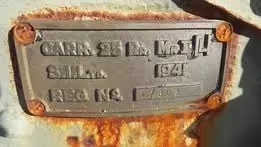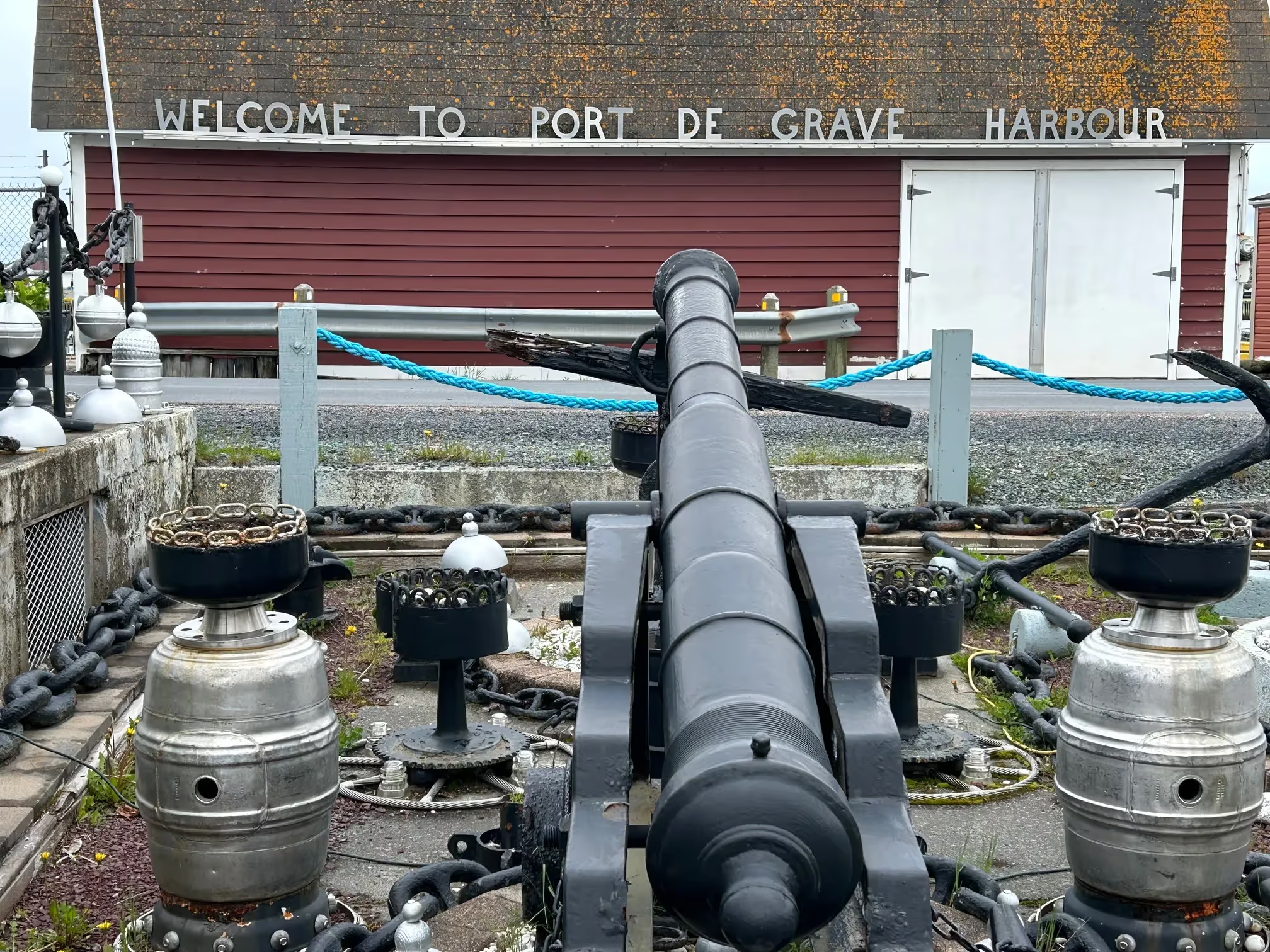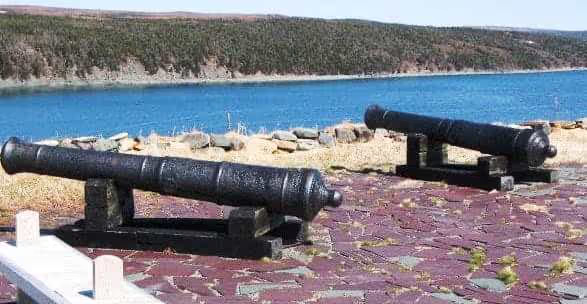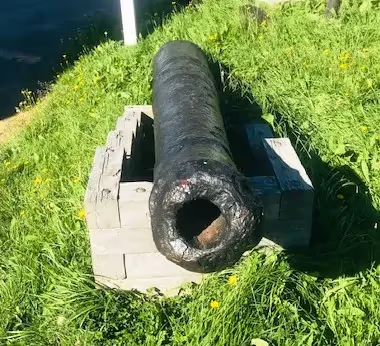Artillery in Canada (10) Newfoundland and Labrador: Happy Valley, Hbr Buffet, Hbr Grace, Hbr Main, Hearts Content, Hearts Delight, Holyrood, La Poile, Mortier, Paradise, Pt Rexton, Renews, Seal Cove, Spaniard's Bay, St. Georges, Tilting, Trepassey, Trinity
Artillery in Newfoundland & Labrador,
Happy Valley, Harbour Buffet, Harbour Grace, Harbour Main, Hearts Content, Hearts Delight, Holyrood, La Poile, Mortier, Mount Pearl, Paradise, Port de Grave, Port Rexton, Renews, Seal Cove, Spaniard's Bay, St. Georges, St. Mary's, Stephenville Crossing, Tilting, Trepassey, and Trinity
For all official data concerning the Royal Regiment of Canadian Artillery, please click on the link to their website:
Royal Regiment of Canadian Artillery Website
The aim of this website is to locate, identify and document every historical piece of artillery preserved in Canada. Many contributors have assisted in the hunt for these guns to provide and update the data found on these web pages. Photos are by the author unless otherwise credited. Any errors found here are by the author, and any additions, corrections or amendments to this list of Guns and Artillery in Canada would be most welcome and may be e-mailed to the author at [email protected].
Note: Back in the day, artillery in Canada was referred to by its radio call sign "Sheldrake". It is now referred to by its "Golf" call sign. (Acorn)
Grey Island
Shipwreck, possibly English, with part of the hull as well as four Smoothbore Muzzleloading Guns on the seabed. Two of the guns are 2.1 metres in length and two are 2.6 metres long. The shipwreck is located in a tickle at entrance to French Cove (Grey Islands).
Happy Valley, Labrador


(Chris Charland Photos)
105-mm C1A1 M2A2 Howitzer, CDN No. unknown, Royal Canadian Legion, Branch No. 51.
Harbour Buffet
German First World War 17-cm mittlerer Minenwerfer (17-cm mMW), medium trench mortar (Serial Nr. unknown).
Harbour Grace


(Terry Honour Photos)
German First World War 17-cm mittlerer Minenwerfer (17-cm mMW), medium trench mortar (Serial Nr. 7417), embedded in a concrete base.


(Terry Honour Photos)
Cast Iron possibly 4-pounder Smoothbore Muzzleloading Gun, heavily corroded, no visible markings, mounted in the sidewalk barrel down, used as a bollard.
Harbour Main

(Heritage Newfoundland Photo)
Cast Iron 9-pounder Smoothbore Muzzleloading Gun, heavily corroded, British Armstrong-Frederick pattern likely dating to about 1760.
Hearts Content
Cast Iron 6-pounder Smoothbore Carronade, Royal Canadian Legion. The Carronade is a short smoothbore, cast iron cannon, which was used by the Royal Navy and first produced by the Carron Company, an ironworks in Falkirk, Scotland. It was used from the 1770s to the 1850s. Its main function was to serve as a powerful, short-range anti-ship and anti-crew weapon. While considered very successful early on, Carronades eventually disappeared as rifled naval artillery changed the shape of the shell and led to fewer and fewer close-range engagements.
Hearts Delight





(Maxwell J. Toms Photos)
German First World War 7.92-mm Shwarzlose MG M.7/12 mounted on a tripod beside the cenotaph.
Hefferen’s Cove
Shipwreck with eleven Smoothbore Muzzleloading Guns laying underwater.
Holyrood
Cast Iron Smoothbore Muzzleloading Guns (two) from a British Warship wreck in Placentia Bay, with a private owner.
La Poile
Cast Iron 3-pounder Smoothbore Muzzleloading Gun, weight 12-2-14 (1,414 lbs), set in a concrete bed on a bluff overlooking the South shore.
Cast Iron 3-pounder Smoothbore Muzzleloading Gun, set in a concrete bed near the village wharf.
Mortier

(Barnable Photo)
Cast Iron Smoothbore Muzzleloading Gun, heavily corroded. This is the fourth of four guns that stood on this site, the other three were pushed off the cliff they overlooked and are now underwater.
Cast Iron Smoothbore Muzzleloading Carronade, partially buried and heavily corroded, about 8 metres west-southwest of the SBML Gun.
Mount Pearl
25-pounder C Mk. 2 QF Field Gun with No. 9 circular firing platform, beside Royal Canadian Legion Branch No. 36.
Placentia artillery is listed on a separate page on this web site.
Nain, Labrador

(Sister Brigitte Schloss Photo)
Three 18th century Smoothbore Muzzleloading Guns stood overlooking Nain Harbour up to the late 1980s. One of these guns came from Okak. They stood in front of the Moravian church and were fired to welcome the Harmone (Moravian Mission ship) when it arrived. These guns have since been buried under a landfill.
Hopedale Mission National Historic Site Canada is a complex of large, wooden buildings constructed by the Moravian Church at Hopedale, Labrador. These large, wooden structures stand starkly silhouetted against the rocky shoreline of the vast, barren landscape.
In 1752, Moravian missionary Johann Christian Erhardt organized a trading and missionary expedition to Labrador. It took 10 years, and the end of the Seven Years’ War in 1763, before another Moravian missionary returned. Jens Haven engaged in three exploration journeys (1764, 1765 and 1770) with the consent and help of Hugh Palliser, the British Governor of Newfoundland. Palliser supported the Moravians’ efforts in the hope that their presence would help resolve Inuit-European tensions. In 1771, Moravian missionaries were the first Europeans to settle in Labrador. Over a 133-year period, they established a series of eight missions along the coast which became the focus of religious, social and economic activities for the Inuit who gradually came to settle near the communities. Moravians had a huge impact on the life and culture of Labrador Inuit. What emerged was a unique culture rooted in Inuit traditions with indigenized European practices. The last Moravian missionary left Labrador in 2005, but the Moravian church, its customs and traditions are still very much alive in Labrador.
Paradise


(Gary Kett Photos)
25-pounder C Mk. 1/4 QF Field Gun, Sorel Industries, Montreal, Quebec, Reg. No. L/803, private owner.
Pont de Grave


(John Mundster Photos)
Likely a replica SBML mounted on a 24-pounder iron garrison carriage.
Port Rexton
.avif)
.avif)
.avif)
(James Stanton Photos)
Cast Iron Smoothbore Muzzleloading Carronade.
Port Rexton, Gun Hill
.avif)
.avif)
.avif)
.avif)
.avif)
.avif)
.avif)
.avif)
.avif)
Cast iron SBML gun, weight 23-0-26 (2,602 lbs), unmounted.
.avif)
.avif)
.avif)
.avif)
.avif)
.avif)
.avif)
King George II cypher.
.avif)
.avif)
.avif)
.avif)
.avif)
.avif)
Cast Iron 9-pounder Smoothbore Muzzleloading Gun, weight 23-0-26 (2,602 lbs), King George II cypher, broad arrow, unmounted.
(James Stanton Photos)
Renews



(Gary Kett Photos)
Cast Iron 6-pounder Smoothbore Muzzleloading Gun, weight 21-1-19 (2,399 Ibs), Hanoverian Bogart patten, King George I, with rose and crown cypher, broad arrow, possibly a G on the left trunnion, possibly an H on the right trunnion, mounted on a wood gun stand. No. 6 engraved on the chase near the muzzle.





(Gary Kett Photos)
Cast Iron 6-pounder Smoothbore Muzzleloading Gun, weight 21-3-6 (2,442 Ibs), Hanoverian Bogart patten, King George I, with rose and crown cypher, broad arrow, possibly IF on the right trunnion, mounted on a wood gun stand. No. 6 engraved on the chase near the muzzle.
The two guns date from the reign of King George I. They are Hanoverian 6-pounders of the Bogard pattern, and had a very short-lived pattern cast between 1716 and 1724. They were soon abandoned because the naval and artillery officers complained they were too light and jumped when fired. They would not have the Browne survey mark, because they are far too late. The 6 indicates its calibre. This is at at time when there were still sakers as well as 6 and 9 pounder guns in use, and gunners were apt to be confused and put the wrong shot in. The engraved number indicates which calibre this gun is and consequently, which size of shot to use. The marks are IF for John Fuller of Heathfield furnace. The G/H I think is Gloucester/Hoathly ironworks, run at this period by the Gott family. Both guns are from the Weald in the south of England. The pattern had a poor reputation and quickly ended up in far off parts of the empire or as bollards. (Ruth Rhynas Brown)
Seal Cove
Cast Iron Smoothbore Muzzleloading Gun, weight unknown, mounted on a wooden carriage, (from Trinity), on display with a private owner.
Quirpon
Shipwreck possibly dating to the 18th century. Underwater, there are remains of the wooden hull and four cast iron smoothbore muzzleloading guns, measuring 1.8 - 2 metres in length. The wreck may be the remains of a French ship lost in 1768 or HMS Neptune lost in 1775.
Shoal Bay
HMS Tweed, built in 1807, was a sloop wrecked in Shoal Bay on 5 Nov 1813 with the loss of 70 of her 122 crew. HMS Tweed was armed with 18 guns, under the command of Captain William Mather. The wreck lies roughly 20 metres underwater and is badly broken up, with cannon, cannon balls and dozens of iron ingots scattered on the seabed. There are no wooden remains of the ship visible.
Spaniards Bay

Captured German 7.92-mm Maxim Spandau MG 08 Machine-gun being examined near Nieuport, Belgium, 15 Sep 1944. (Library and Archives Canada Photo, MIKAN No. 3250984)




(Maxwell J. Toms Photos)
German First World War 7.92-mm Maxim Spandau MG 08 Machine-gun (Serial Nr. unknown), top cover missing, mounted on a Schlitten stand.
German First World War 7.58-cm leichtes Minenwerfer neuer Art, (7.58-cm leMW), (Serial Nr. unknown). Royal Canadian Legion Branch No. 32.
St. Georges


(Maxwell J. Toms Photos)


(Terry Honour Photos)
German First World War 7.58-cm leichtes Minenwerfer neuer Art (7.58-cm leMW), (Serial Nr. 3838), light trench mortar. Royal Canadian Legion Branch No. 38.
St. John's artillery is listed on a separate page on this web site.
St. Mary's
Cast Iron 9-pounder Smoothbore Muzzleloading Gun, mounted on a naval gun carriage, No. 1 of 4. This is the only original gun of the four original cannons installed in 1779, with three additional guns recently sourced.
Cast Iron 9-pounder Smoothbore Muzzleloading Gun, mounted on a naval gun carriage, No. 2 of 4.
Cast Iron 9-pounder Smoothbore Muzzleloading Gun, mounted on a naval gun carriage, No. 3 of 4.
Cast Iron 9-pounder Smoothbore Muzzleloading Gun, mounted on a naval gun carriage, No. 4 of 4.
The original four guns were part of Queen’s Battery Park, originally installed by the British to defend the community of St. Mary’s and protect the Newfoundland fishery in the late 1700s. The St. Mary’s Queen’s Battery Restoration Committee is working to restore the site, with plans to turn the area into an interpretative park and draw more visitors to the town. The battery went into service in 1779 and ended its commission in 1815. It was the only battery to have been actively engaged during the years of the War of American Independence (1775-83), capturing an American privateer in 1782. American privateers were quite active during the war against the British, and disrupting the migratory fishery in Newfoundland was a major target.
Only one of the original cannons remains in place at the St. Mary’s battery site, an area known locally as The Point. That cannon is weathered and corroded, but is still in relatively good shape. The three other original guns are presumed to have ended up in the ocean, either falling from their mounts some years ago due to the corrosion of the shoreline or being taken and used as ballast for wharf construction in the late 1800s.
The battery at St. Mary’s was one of seven small batteries built on the Avalon Peninsula at the time. The others were located at Bay Bulls, Ferryland, Fermeuse, Renews, Trepassey and Petty Harbour. The decision to provide those outports with the means of self-defence against American privateers was made in the summer of 1778 by Newfoundland governor John Montagu, although the idea had already surfaced before then.
Captain Robert Pringle of the Royal Corps of Engineers had favoured arming the outports as part of a plan he had submitted to the Board of Ordnance in 1773 for the defence of the fishery. In 1779, Trepassey and St. Mary’s each received four 9-pounder smoothbore muzzleloading guns. The guns in the battery at St. Mary's came from the 26-gun HMS Proteus, a Royan Navy ship anchored in St. John's harbour which had become worn out and unfit for further service. The battery was used in the capture of the privateer Hazard on 16 Sep 1782.
The restoration committee has obtained a copy of the letter written by then Newfoundland governor John Campbell regarding the capture. The letter, dated 2 Oct 1782, thanks the people at St. Mary’s for “your very spirited conduct in taking the Hazard, privateer.” It further asked the recipient of the letter to “inform the inhabitants and others who so bravely assisted you upon the occasion, that I very much approve of their conduct and cheerfully resign all right of title to the prize, which I hope will be disposed of to the satisfaction of everybody concerned.”

(The Rooms Photo, Newfoundland Heritage Archives)
26-gun HMS Proteus.
Stephenville Crossing
German 25-cm schwerer Minenwerfer alt Art, (25-cm sMW), (Serial Nr. unknown), Flat Bay, Stephenville Royal Canadian Legion Branch No. 38.
Tilting

Cast Iron Smoothbore Muzzleloading Gun. This heavily corroded but still trunnioned Gun lies at Tilting on Fogo Island. It may have been a merchant's gun placed to guard the harbour, perhaps in the American Revolutionary War period. (Alan Cass, Carbonear Historical Society)
Trepassey, Chance Cove Provincial Park

(Michael Shelbourn Photo)
In 1778 merchants and citizens of Trepassy petitioned the British government for help in staving off American privateers who raiding the coast seizing ships, stealing cargoes and raiding settlements. The crown arranged for a series of small batteries armed with cannon to protect the coast, to be manned by local citizens. Four 9-pounders were installed inside an earthwork covering the harbour entrance at Trepassy. Two gunners from the Royal Artillery were stationed in the town. Normally an additional ten men were required to serve the guns, and these had to be made up by the citizens. By 1797, the battery had deteriorated, and was never repaired. There are two guns on site.
Cast Iron 9-pounder Smoothbore Muzzleloading Gun, weight and maker unknown, No. 1 of 2.
Cast Iron 9-pounder Smoothbore Muzzleloading Gun, weight and maker unknown, No. 1 of 2.
Trinity


(Jim Miller Photos)
.avif)
(John Mundster Photo)
German First World War 7.7-cm Feldkanone 96 neuer Art Field Gun (Serial No. 7661). Rebuilt in 2007 by Jim Steinhauer and Nelson Sherren. The gun has new wheels, was cleaned and the metal work restored and painted with epoxy paint. According to a "Report of Disposition of War Trophies to 19 February 1921 (Journal of the House of Assembly of Newfoundland)", a captured German Field Gun (likely an FK 97) was sent to Trinity on 31 Dec 1920. This is most likely the same gun, Serial Nr. to be confirmed.
.avif)
(John Mundster Photo)
Cast Iron Smoothbore Muzzleloading Gun, weight and maker unknown, unmounted.



(James Stanton Photos)
Cast Iron Smoothbore Muzzleloading Gun, weight and maker unknown, mounted on a concrete stand, in front of the town hall.
Trinity Bay, Fort Point

(Trinity Historical Society Photo)
Cast Iron Smoothbore Muzzleloading Gun, weight and maker unknown, mounted on a wood stand, No. 1 of 4.
Cast Iron Smoothbore Muzzleloading Gun, weight and maker unknown, No. 2 of 4.
Cast Iron Smoothbore Muzzleloading Gun, weight and maker unknown, No. 3 of 4.
Cast Iron Smoothbore Muzzleloading Gun, weight and maker unknown, No. 4 of 4, all facing the sea.
Fort Point, also known as Admiral’s Point, was fortified in 1746 with three batteries mounting 18 guns, a store house, a powder magazine, barracks for 224 soldiers and a pavilion for 9 officers, all surrounded by parapets and palisades. During the 1740s, the fort was garrisoned with only one artillery officer and 20 men, and an infantry officer with 30 soldiers. In 1748, theses fortifications were improved as they appear in “A Plan of the Admirals Point in Trinity Harbour, Newfoundland in 1748.” This plan shows a 15 gun battery, a 3 gun battery and a 4 gun battery, parapet walls, Storekeepers Hut, Gunners Hut, Storehouse, Magazine and intended Barracks. This “intended barracks” was probably built soon after to accommodate the garrison of Royal Artillery men. (Trinity Historical Society)

I would imagine that many of you who are reading this book are very likely familiar with the standard routine of military training exercises and the rigours of being in the field in all seasons, not to mention the conditions found on deployment these days. Whether or not you have experienced it, I am sure you can well imagine what it is like to train and work in the heat, the dust and the mosquitoes in summer, the wind, the rain and the mud in the spring and fall, the snow and the cold in the winter and of course the routine day-to-day challenges of combat exercises in the training areas of the Canadian Forces. For most in the Army, this includes CFB Gagetown, CFB Valcartier, CFB Petawawa, CFB Kingston, CFB Shilo, CFB Edmonton, CFB Wainwright, CFB Suffield and all the fields and exercise areas of LFAATC Aldershot and LFCATC Meaford and their environs.
As an Army Officer in the Canadian Forces, it has been my privilege to have served alongside a tremendous number of highly professional military men and women of our nation while taking part in training in Germany, the UK and the USA and while on operational deployments to Cyprus, Bosnia-Herzegovina and in Afghanistan. During my training and military professional development, I have learned much about our long military history. My interest in our multi-faceted historical record has led me to write about it and to seek out the stories about Canada's military servicemen and women and the tools and equipment they used to preserve our security when warclouds darkened our horizons.
As a military history enthusiast, I have learned over the years that there are many with similar interests in preserving our story. We have all seen the odd old gun or retired tank placed on display outside a Militia Drill Hall, War Memorial, city park site or Royal Canadian Legion Hall, and many will have enjoyed visiting a number of our military Museums. The vast majority of retired wartime combat equipment used by members of the CF have dwindled in number, many being scrapped, others being shot up as targets, while a few have been sold to overseas operators and collectors. Fortunately, a handful of important examples of retired CF guns and war machines have been preserved and may be found in a wide variety of locations throughout Canada.
Curators, docents and volunteers working in Canada's military museums have been successful in preserving a good number of retired military weapons of war and many are still being sought after and in some cases, being restored to running condition again. As an artist, photographer and military history enthusiast, I have attempted to keep track of where historic Canadian military equipment has survived and is presently located and to make that information available to others with the same interest. For those of like mind, the purpose of this handbook is to provide a simple checklist of the classic Great War and WWII artillery that is part of our military heritage and a location guide to where they can be found in Canada. The book includes a number of photographs to illustrate an example of each gun wherever possible, and lists the locations of the survivors by province.
The numbers of restored Canadian guns is actually increasing as a few rare examples are being recovered from scrapyards and monument sites and salvaged for restoration. (Ultra rare items such as Skink AA gun turrets come to mind). One of the aims of this book is to help an enthusiast track down these monuments and museum artefacts and to have a simple reference book on hand with more detailed information about them such as a serial number, a Museum location and contact information which might be helpful in learning a bit of the history of a particular vehicle. The guns detailed in this handbook are listed alphabetically by manufacturer, number and type in the order that they came into service with the CF. The data is also appended with a list of most of the current guns found in the various collections and Museums in Canada. The book is also meant to serve as a companion volume to "Ironsides", Canadian Tanks and Armoured Fighting Vehicle Museums and Monuments, also available online.
It is my sincere hope that more of the guns and artillery found in this list will one day be added to the record of historically important military armament survivors that have been recovered and restored.
Shelldrake can be ordered online in softcover or e-book at these bookstores:
http://bookstore.iuniverse.com/Products/SKU-000542288/Shelldrake.aspx
Photos and technical data on artillery preserved in Canada may be viewed by Province on separate pages on this website.





